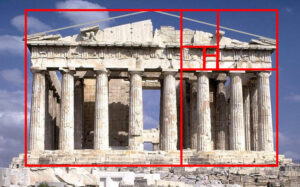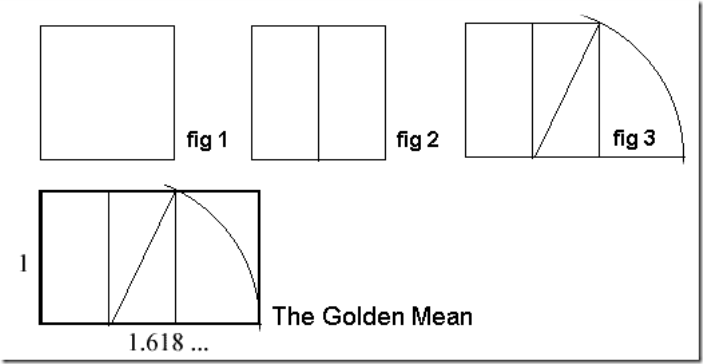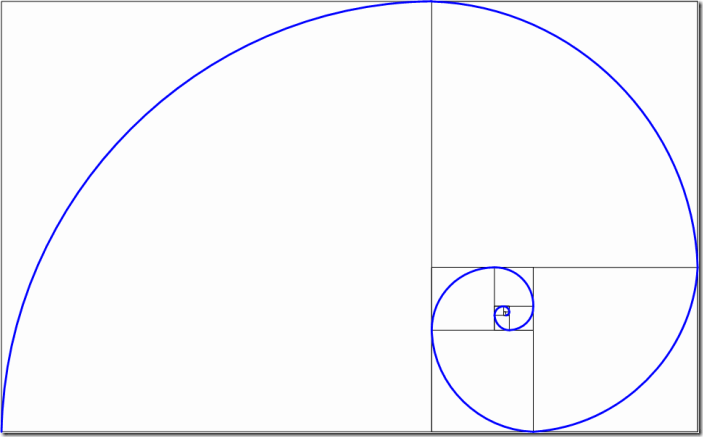
Discovering Gold
Understanding The Golden Section in Landscape Design

Whether or not you are good at, or interested in mathematics doesn’t matter here. Read on. The golden ratio is a fascinating and immensely useful little bit of insider knowledge for designers creating garden plans and is also surprisingly straightforward to grasp, even for maths duffers like me. It is the mathematical relationship most often referred to as the golden ratio, the golden section, the golden mean, or simply phi. They all mean the same thing. It is a ratio of 1 to 1,618.
This ratio can be discovered in many many forms – in nature, in music, architecture, art and even the proportions of the human figure. Apply the golden ratio to the proportions of a rectangle and you have a golden rectangle. It is one of the most appealing of all the forms in geometry and has been described as the Divine Proportion. It’s very possible that the Egyptian pyramids were built using the golden ratio and the Greek Parthenon in Athens certainly was. Paintings using the golden ratio as a base for the composition of a subject always look harmonious, although no one has yet been able to pinpoint exactly why it works so well. Many Renaissance painters used the golden ratio to achieve harmony and balance in their works. The most famous examples being Leonardo da Vinci’s Last Supper, The Mona Lisa and Vitruvian Man.
So, how to use this magic tool? A simple garden layout based on the golden ratio will naturally achieve harmony and beauty – a gift on a plate. Remember that even if the garden is an awkward shape you may still be able to impose the golden rectangle within it (see my blog on Strong and Weak Ground Patterns).
The golden rectangle is shown as a large rectangle, divided into a square and another rectangle. The unique property of this sequence is that it can be repeated indefinitely within each section. Once you start to draw golden rectangles you will see how this works and you can begin to identify golden ratios in plants, buildings, paintings and many more objects found in nature or designed by humans.
You can take this further. The golden ratio is related to the golden spiral, otherwise known as the Fibonacci spiral. The Fibonacci sequence was discovered in 1200AD by an Italian mathematician and it links directly with the golden ratio. How does it work? Basically the ratio of any two successive Fibonacci numbers is close to the golden ratio. The higher the numbers the closer the ratio, so that by the time you get to 144: 233 the ratio is 1.618. You can look up the sequence on the internet.
A while back I was commissioned to design a terrace, backed by a lovely old, high brick wall, but some way from the main house and therefore almost a secret surprise. It had great views and was sheltered. The client gave me an open brief. Initial discussions with him revealed that he was a lecturer in mathematics. Almost immediately I thought maybe I could surprise and please him with the notion of a Fibonacci spiral set into the terrace. It would provide interest, a talking point for visitors and a direct link with his profession and passion, as well as being an entirely natural mathematical form found in seashells, fir cones and flowers.
I was lucky and it was a success. Being an open brief it was relatively unrestricted by budget. Blue engineering bricks inscribed the spiral, within a terrace of second hand bricks carefully complementing those of the existing old wall. I mentioned an unrestricted budget because there was, of course a certain amount of cutting to achieve the shape and the spiral had to be exact.
Very often you will meet extremely interesting clients. Talking and listening to them will give you insights, ideas and inspiration to create a garden or garden feature that is absolutely right for them.


